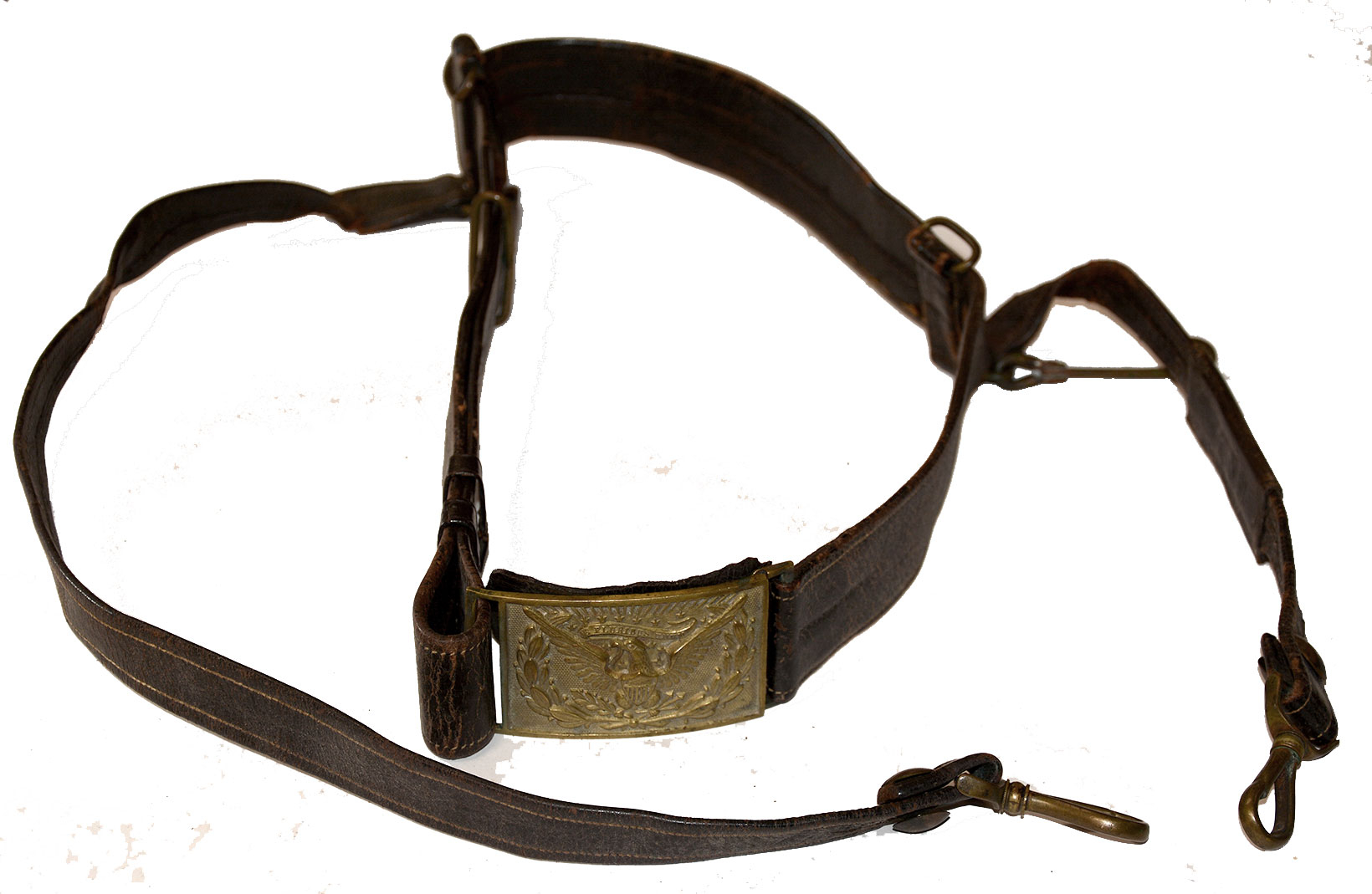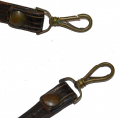site search
online catalog
CIVIL WAR US REGULATION MODEL 1851 OFFICER’S SWORD BELT

$695.00 SOLD
Quantity Available: None
Item Code: 286-1352
This is a very good example of the regulation Civil War Union officer’s sword belt. Officers were required to supply their own uniforms, weapons, and equipment, which came from commercial suppliers by private purchase. An officer’s sword belt might thus show some minor variation, but was governed by sections 1509 and 1511 of the 1861 uniform regulations as follows: “1509. For all Officers-a waist-belt not less than one and one-half inch nor more than two inches wide to be worn over the sash; the sword to be suspended from it by slings of the same material as the belt, with a hook attached to the belt upon which the sword may be hung.” And, “1511. For all other Officers-black leather plain.” The sword belt plate was governed by section 1513: “For all Officers and Enlisted Men-gilt, rectangular, two inches wide a raised bright rim; a silver wreath of laurel encircling the ‘Arms of the United States;’ eagle, shield. Scroll, edge of cloud and ray bright. The motto, ‘E Pluribus Unum,’ in silver letters, upon the scroll; stars also of silver; according to pattern.”
The belt and slings in this case are made of folded and sewn leather, usually over a web or canvas core, with the slings provided with snap hooks for the sword scabbard, and attached by oval brass rings to sliding belt loops, which also have a ring at the top for attachment of a removable shoulder belt. The sliding belt loops enable the belt to be worn also without the slings. This is in very good condition. The leather finish has oxidized slightly toward brown and there are scattered wear spots, rubs and scrapes from use, but the belt is solid and has not been treated with any polish, dressing, or preservatives. Both slings are in place and have their snaps hooks buttoned to the ends by small double-headed brass studs. The brass loop for the forward sling has a narrow brass carrying hook as well and the sling itself has a sliding safe over the upper portion to keep the sword hilt from rubbing too much against the unform. Both slings show some wear from bending at the upper end just below the overlap securing them to the oval brass loops on the slides.
The belt plate is the regulation pattern adopted in 1851 and shows the superior die work usually found on commercial plates. The high quality silver wash applied to the wreath is gone as usual from wear and handling, but the details are excellent and both plate and hasp have a pleasing medium patina. (Ironically, the cheaper nickel wreaths sweated onto the enlisted plates usually stay bright, just as the cheaper issue buff leather belts are often in better condition than officer’s belts made of more expensive leather.) The reverse is fitted with a wide tongue fitting the hasp sewn onto the other end of the belt, the width offering more stability to the fit and not being an indicator of date (as it would be on an enlisted plate.) The leather safe that extends behind the plate to protect the uniform shows some expected wear along the edges from rubbing by the uniform. The two leather slides on the waist belt are in place. The stitching holding the narrow brass wire adjusting buckle on that end of the belt gave way, but it is still in place, though missing its small tongue.
This would go far to complete and officer’s display when shown with an officer’s frock coat, sword, and sash. [sr][ph:L]
~~~~~~~~~~~~~~~~~~~~~~~~~~~~~~~~~~~
THIS ITEM, AS WITH ALL OTHER ITEMS AVAILABLE ON OUR WEB SITE,
MAY BE PURCHASED THROUGH OUR LAYAWAY PROGRAM.
CLICK HERE FOR OUR POLICIES AND TERMS.
THANK YOU!
Inquire About CIVIL WAR US REGULATION MODEL 1851 OFFICER’S SWORD BELT
For inquiries, please email us at [email protected]
Most Popular
Historical Firearms Stolen From The National Civil War Museum In Harrisburg, Pa »
Theft From Gravesite Of Gen. John Reynolds »
Selection Of Unframed Prints By Don Troiani »
Fine Condition Brass Infantry Bugle Insignia »
Wonderful Condition Original Confederate-Manufactured Kepi For A Drummer Boy Or Child »
featured item
CAPTURED CONFEDERATE SECOND NATIONAL FLAG, UNUSUAL VARIATION WITH MADAUS LETTER, FROM A SOLDIER IN THE 59th NEW YORK
This 2nd National Confederate Flag was purchased in the 1980s by a well-respected Florida dealer/collector directly from descendants of the Union soldier who had kept it as a trophy. It comes with a 1988 letter on Milwaukee Public Museum letterhead… (1179-019). Learn More »
















